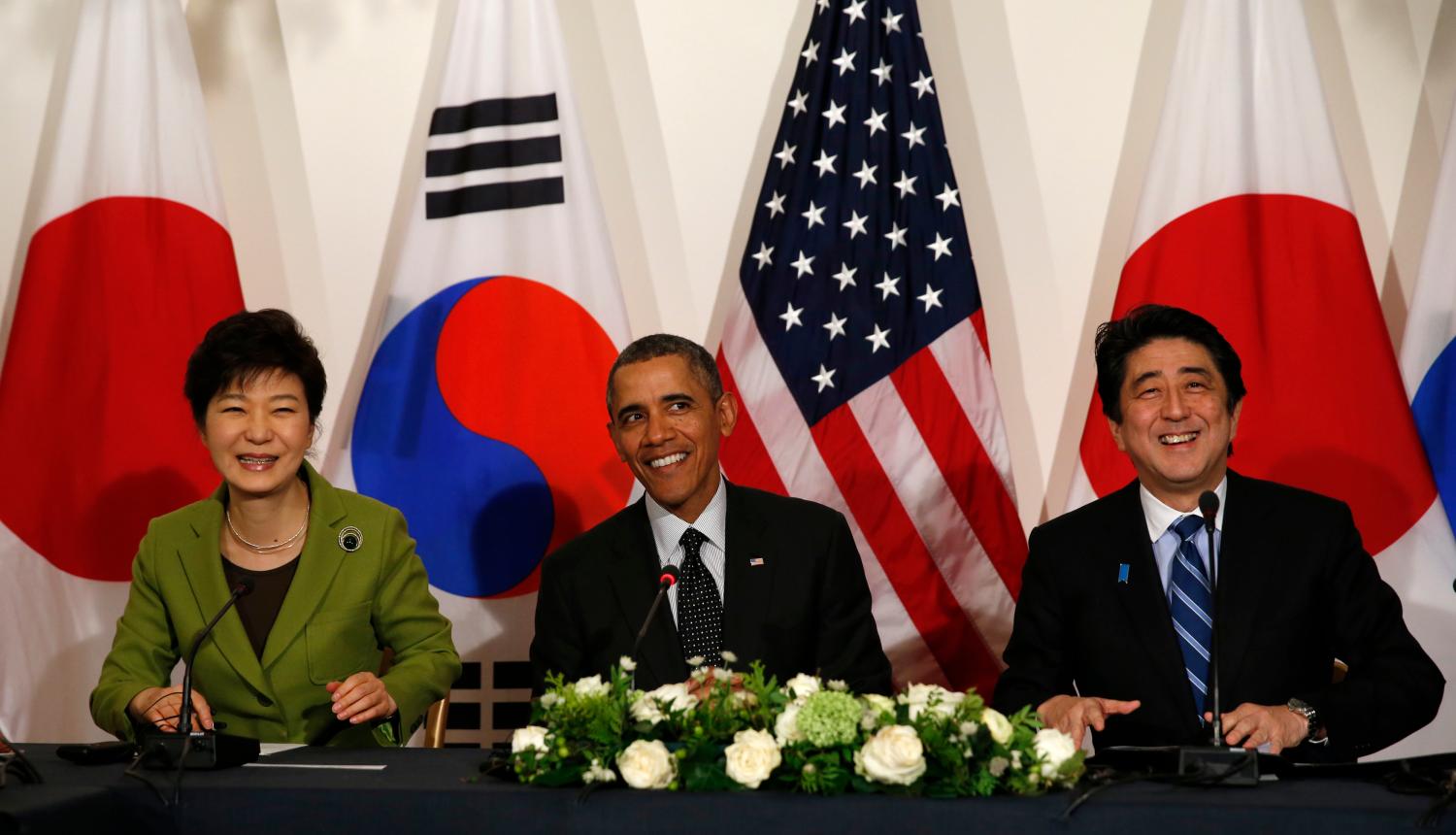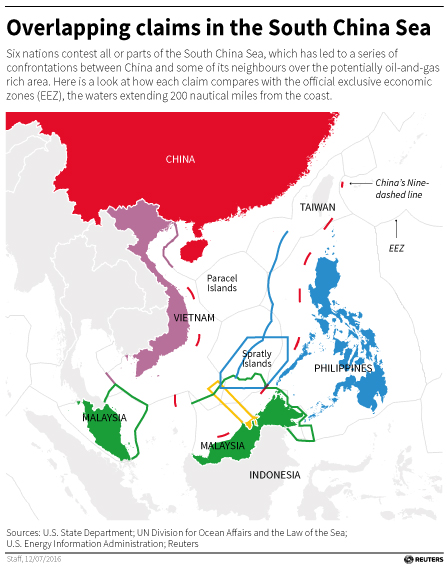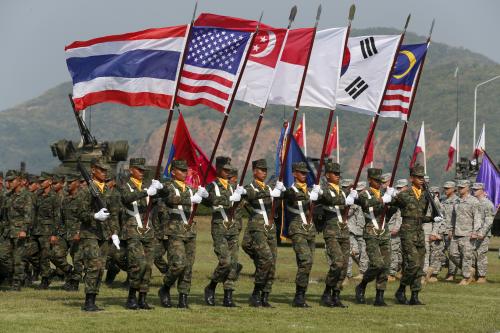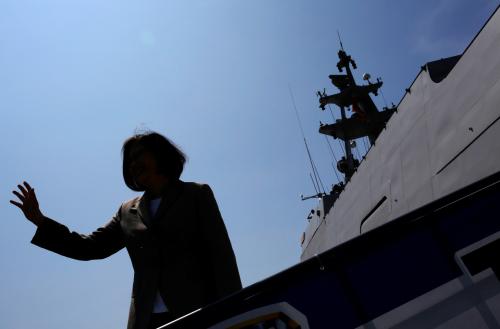The following brief is part of Brookings Big Ideas for America—an institution-wide initiative in which Brookings scholars have identified the biggest issues facing the country and provide ideas for how to address them. (Updated January 27, 2017)
 President-elect Donald Trump argued during the 2016 campaign that U.S. alliances around the world are a bad deal for America, because our allies do not pay enough for the security we provide. Trump’s approach displays a basic misunderstanding of the alliances’ value for the United States. Regarding East Asia, he is seemingly unconcerned with the deep anxieties his ideas have provoked among our security partners in the region about the very credibility of our commitment. Yet Trump’s proposal does serve something of a useful purpose. It provides an occasion to review why these arrangements benefit the United States.
President-elect Donald Trump argued during the 2016 campaign that U.S. alliances around the world are a bad deal for America, because our allies do not pay enough for the security we provide. Trump’s approach displays a basic misunderstanding of the alliances’ value for the United States. Regarding East Asia, he is seemingly unconcerned with the deep anxieties his ideas have provoked among our security partners in the region about the very credibility of our commitment. Yet Trump’s proposal does serve something of a useful purpose. It provides an occasion to review why these arrangements benefit the United States.
Background
The United States has had a naval presence in the Pacific and East Asia since the mid-nineteenth century, but it was not until after World War II that it decided to conclude alliances with friendly regional countries with a commitment to defend them in case of aggression. In the early 1950s, to facilitate the containment of communism, Washington struck bargains with countries on China’s periphery—Japan, South Korea, Taiwan, the Philippines, Thailand, Australia, and New Zealand—committing itself to their defense in return for permission to base significant U.S. forces on their soil.
A fundamental judgment drove U.S. policymakers to pursue alliance building in East Asia and Europe: prewar isolationism had only rendered America more vulnerable, not less. The United States could best protect itself by establishing an active forward presence on both ends of the Eurasian landmass. Alliances and the overseas deployment of U.S. armed forces were therefore instruments in a larger strategy. Forward deployment of military forces not only pre-positioned the capabilities needed for war-fighting if war should ever come, but also enhanced deterrence by sharpening the risk calculus of friends and adversaries alike: reassuring allies and warning enemies. Like cops on the beat, moreover, the constant presence of American forces in East Asia fostered a long period of relative regional stability, with the Vietnam War as the exception that proved the rule. There were, of course, important economic, political, and cultural elements to U.S. policy, but forward deployment was the key. Asian alliances were never seen as favors to the countries concerned; American leaders believed that helping to keep our friends safe would better secure our homeland.
The United States thus became what Robert Gates, secretary of defense in the Bush and Obama administrations, would call a “resident power in East Asia.” But the U.S.-led security order was not completely static. In a dramatic shift, presidents Richard Nixon and Jimmy Carter induced China’s leaders to align their country with the West against the Soviets. America and its friends in the region worked to incorporate China into the international capitalist economy and to try to bind it to the institutions, regimes, norms, and laws that helped regulate international society. Even as the Cold War continued, its character in Asia had changed. The post-1978 emergence of China from its past isolation actually reinforced America’s basic strategy, and the U.S. alliances and the forward deployment they enabled fostered a stable environment in which the countries of the region—including China itself—saw accelerated economic growth and, in some cases, made the transition to democracy. Although these alliances served the specific purpose of deterring the adversaries of the United States’ allies, the broader presence that the alliances symbolized brought a strategic stability for allies and nonallies alike.
The collapse of the Soviet Union in 1991 naturally raised questions about whether East Asian alliances were necessary. The threat from Moscow no longer existed. China might be powerful in the long term, but not in the near and medium term. Meanwhile, trade and investment were drawing the countries of the region together, and fear of interstate conflict declined substantially. Thailand, New Zealand, and the Philippines even chose to let their alliances with America atrophy.
Alliances today
Even though the global Cold War had ended by the early 1990s, a Cold War–like phenomenon had emerged in northeast Asia. The source was Stalinist North Korea, which had maintained a conventional threat against the South since the end of the Korean War in 1953. By the 1980s, Pyongyang had systematic programs to develop nuclear weapons and the means to deliver them over long distances. Its economy was autarkic, and its political system was severely repressive. American and South Korean attempts to divert North Korea diplomatically from its hostile path were to no avail, for the simple reason that North Korea did not wish to be diverted. Pyongyang’s nuclear and missile programs created an existential threat to both South Korea and Japan, which in turn have deepened their security cooperation with the United States.
Most significant for the long term, since the late 1970s China has gradually but systematically rebuilt its national power and ended almost two centuries of relative weakness. Beijing began by strengthening its economy and diplomacy, but it is now developing maritime, air, and missile capabilities to project military power within East Asia and beyond. The growth of China’s power and the more assertive exercise of its political influence have increased anxieties through most of the region and sometimes worked to the diplomatic disadvantage of the United States. Still, China is not the old Soviet Union. It is more integrated economically with the world than the Soviet Union ever was. Its demand for natural resources and advanced components for assembly into high-tech electronic devices, plus the thirst of developed countries for low-cost consumer goods, has made China the engine of global economic growth. In different ways, the countries of East Asia depend on China for their prosperity, and declines in Chinese growth hurt their own economic prospects.
Still, as much as we might hope that East Asia might be a domain of peaceful coexistence, it is not. Dangers exist, and the friends and adversaries of the United States cannot help but prepare for the worst, even if they hope for the best. The conceivable circumstances in which war could occur are clear:
- North Korea initiates a low-level conventional attack against South Korea. South Korea carries out its threat to retaliate, the conflict escalates, and China and the United States get drawn in, with Beijing on Pyongyang’s side and Washington in support of Seoul.
- In the East China Sea, a physical clash between Japanese and Chinese coast guard vessels destroys the current yet fragile standoff surrounding the Senkaku/Diaoyu islands. The navies of the two countries get drawn in and the conflict escalates, and the United States intervenes to assist Japan.
- Either China continues to expand its physical and military presence in the South China Sea, to the point of effectively seizing land forms held by Vietnam, the Philippines, and others, or there is a serious clash between U.S. and Chinese naval ships; and the conflict escalates.
- Taiwan’s leaders take political steps that China interprets (rightly or wrongly) as moves toward de jure independence, which Beijing opposes. China then undertakes political, diplomatic, and military intimidation of Taiwan; the United States supports Taiwan; and the conflict escalates into a U.S.-China war.
The chance that any of these scenarios might occur is probably low, but it is not zero. Misperception, miscalculation, and domestic nationalisms would likely be at play. Leaders of all the countries concerned understand the economic stakes of military conflict, and they could use diplomacy and conflict-reduction measures to reduce the danger of war. They have done so successfully in the past.
The risks of conflict thus can be reduced, but they cannot be eliminated. Nor can the possibility be dismissed that the United States might choose to intervene to defend its allies and protect its own interests. Yet the idea that the intervening American forces are latter-day Hessians—the equivalent of mercenaries subcontracted to foreign governments—is simplistic and wrong.
Smart deterrence is a good deal for the United States.
First of all, our alliances do not exist solely to defend our allies in the case of war. They have successfully deterred adversaries from initiating war in the first place. So far, our capabilities and those of our allies, plus the credibility of our willingness to use them, have convinced our adversaries that the risks and costs of conflict are not worth the benefits to be gained. But to raise doubts about U.S. resolve by suggesting, for example, that U.S. armed forces would defend our allies only if the price is right would only invite the adventurism that we wish to prevent. Smart deterrence is a good deal for the United States.
Second, it is wrong to assume that the United States would bear the combat burden. The Korean and Japanese armed forces are some of the most capable in the world. They plan on the assumption that if (God forbid) war occurs, they would have the primary responsibility to fight and die to defend their homelands. The United States would play a supporting role, with capabilities that only we possess. Despite our supporting role and the robust mechanisms that integrate our respective defense forces, our allies’ knowledge that we have their backs gives them far greater confidence to fight and maybe die.
Third, the idea that the U.S. taxpayer is paying all the expenses for U.S. forces in East Asia has no factual basis. Objective data show that Korea and Japan each cover around half of the direct costs of the presence of U.S. forces in their countries. To take the forces we currently deploy in Japan and Korea and base them back in the United States probably would not save any money and certainly would make war-fighting harder.
The most graphic demonstration of the generosity of our friends has to do with the U.S. Marines that have been deployed on Okinawa. The U.S. and Japanese governments decided that 5,000 of these troops should be relocated to the American territory of Guam. Not only will Japan pay for the actual relocation costs, but it will also construct new facilities on Guam.
Deterrence and burden sharing aside, the United States and its leading allies—Japan and Korea—recently have used their alliances as vessels for much broader policy cooperation. In both cases, there is growing attention to issues of security outside East Asia, such as Iran’s nuclear program, and an array of nonsecurity objectives including global economic growth, sustainable development and poverty reduction, global health, climate change and environmental protection, cybersecurity, and science and technology cooperation.1
To be sure, America’s alliances do not come without liabilities:
- Each of our Asian partners has strong antennae to pick up any signal that Washington is about to abandon it. Each sometimes fears that alignment with the United States will lead to its entrapment in a conflict it does not desire.
- The United States is not always satisfied with how much our allies spend on defense and on what capabilities they acquire. This becomes very important if a U.S. ally is the victim of attack, for it must be able to hang on until U.S. forces intervene in strength, and the clear ability to hang on strengthens deterrence.
- Washington is periodically afraid that the actions of a U.S. ally or security partner will entangle it in an unnecessary dispute or conflict (that the “tail will wag the dog”).
- America’s friends in the region may disagree with Washington on the appropriate way to respond to the security challenge of the moment (for example, China’s incremental campaign to expand its presence and capabilities in the South China Sea).
- Nationalistic public opinion in some countries of East Asia sometimes has been hostile toward the United States because of its security and political role.
Yet none of these problems is new, and Washington has a wealth of experience on managing each. There is no reason why it cannot apply past experience to new situations. That the countries of East Asia plus the United States with its forward presence have been able to keep the peace in East Asia should lend confidence that they can continue to do so. From this historical perspective, therefore, the Obama administration’s “rebalance” or “pivot” is not a new policy at all, but more an adjustment of a decades-old strategy to new circumstances.
Alliances in a changing Asia (China)
What is new in East Asia is how China’s growing power—and the way it has been used—presents new challenges for America’s friends in the regions and for our security relationships with them. East Asia is where China’s revival as a great power will first take place, and the region already has its share of medium to strong powers. From China’s perspective, creating strategic depth into the East and South China seas makes sense in terms of its defense strategy, and it has steadily built the military capabilities to create that depth. Yet it is encroaching into areas where other powers’ armed forces are already present—first and foremost the United States, and secondarily Japan.
To make matters worse for Beijing, its neighbors keep a constant watch on the activities of its military and paramilitary capabilities. The way China has used its assets to establish a new presence in the East and South China seas and to assertively advance its territorial and maritime claims has made most of its East Asian neighbors nervous about its long-term intentions. Their default response is to align more closely with the United States, at least when it comes to security. On trade and investment, however, they reap the benefits that stem from a large and modernizing Chinese economy. The last thing that China’s neighbors want is to have to make a choice between China and the United States.
Chinese officials and scholars have sought to turn the rhetorical tables on the United States by complaining more and more about the security architecture that Washington built and has sustained in its neighborhood. They start with the assumption that alliances exist by definition to counter an enemy, and then infer that China must be America’s new adversary. This logic betrays a serious problem in China’s decisionmaking system: reflexively viewing the actions of the United States as part of a plot to contain China, even though those actions usually have an alternative and benign purpose (or, sometimes, are a response to Chinese actions). This logic ignores the significant, long-term stabilizing impact that U.S. security policy has had in Asia, through alliances and other means. Moreover, Washington has played an important role in trying to resolve or mitigate disputes within the region so that they do not spin out of control, and has sometimes discouraged its friends from taking steps that would unnecessarily increase tensions. Both of these actions benefit China’s interests.
Still, there is a security dilemma at play between the United States and China, one that can affect the region as a whole. Even if rivalry is not inevitable, neither is it impossible. Washington’s actions may and do foster perceptions in Beijing that U.S. intentions constitute a hostile containment policy and require a robust response. China’s actions create fears in the United States that Chinese leaders wish to drive it from the region, fears that are shared doubly by our regional allies and friends. The danger of a vicious circle is real. If the United States overreacts to Chinese moves, it may only invite more extreme steps by China. (As Harvard’s Joseph Nye famously warned: “If you treat China as an enemy, you are certain to have an enemy.”) But if Washington sits idly by in the face of Chinese provocations, our allies will be alarmed.
A serious and more practical challenge is the effect of China’s military modernization capabilities. Sooner or later, it will have the ability to project significant air and naval power out to at least the first island chain (formed by Japan, Taiwan, and the Philippines). Simply acquiring the ability to project power in that way does not necessarily mean that Beijing will use that power. Nor does it mean that China will refuse to coexist with its littoral neighbors and the United States. But if China has this power-projection capability, it could change the way that the United States would have to fight China if there should ever be a major war, which in turn might require changes in alliance arrangements at political and operational levels.
Generally, the direction of U.S.-China policy might be summarized as: “cooperate where we can but contend when we must.”
Generally, the direction of U.S.-China policy might be summarized as “cooperate where we can but contend when we must.” Washington’s hope is that China will pursue a similar approach and the two states together can manage areas of contention well enough to avoid exacerbating mutual suspicions. For the United States, moreover, its alliances and security partnerships in East Asia remain a force for regional stability and an asset for setting benign parameters to channel China’s rise. There will be frictions and contention between China and the United States and between China and its Asian neighbors. The task will be to mitigate and contain those problems through a variety of mechanisms, including diplomacy and military confidence-building measures. If China is prepared to exercise restraint as it projects power outward, that is the best outcome. If, through its own actions, it stimulates deterrence responses from the United States and its friends, alliance relationships are more likely to succeed than individual effort.
-
Footnotes
- For a more detailed discussion of U.S. alliances and security partnerships in Asia, see the series of papers produced at Brookings on the subject, available at brookings-edu-2023.go-vip.net/research/alliances-partnerships-u-s-commitments-in-the-asia-pacific.
The Brookings Institution is committed to quality, independence, and impact.
We are supported by a diverse array of funders. In line with our values and policies, each Brookings publication represents the sole views of its author(s).










